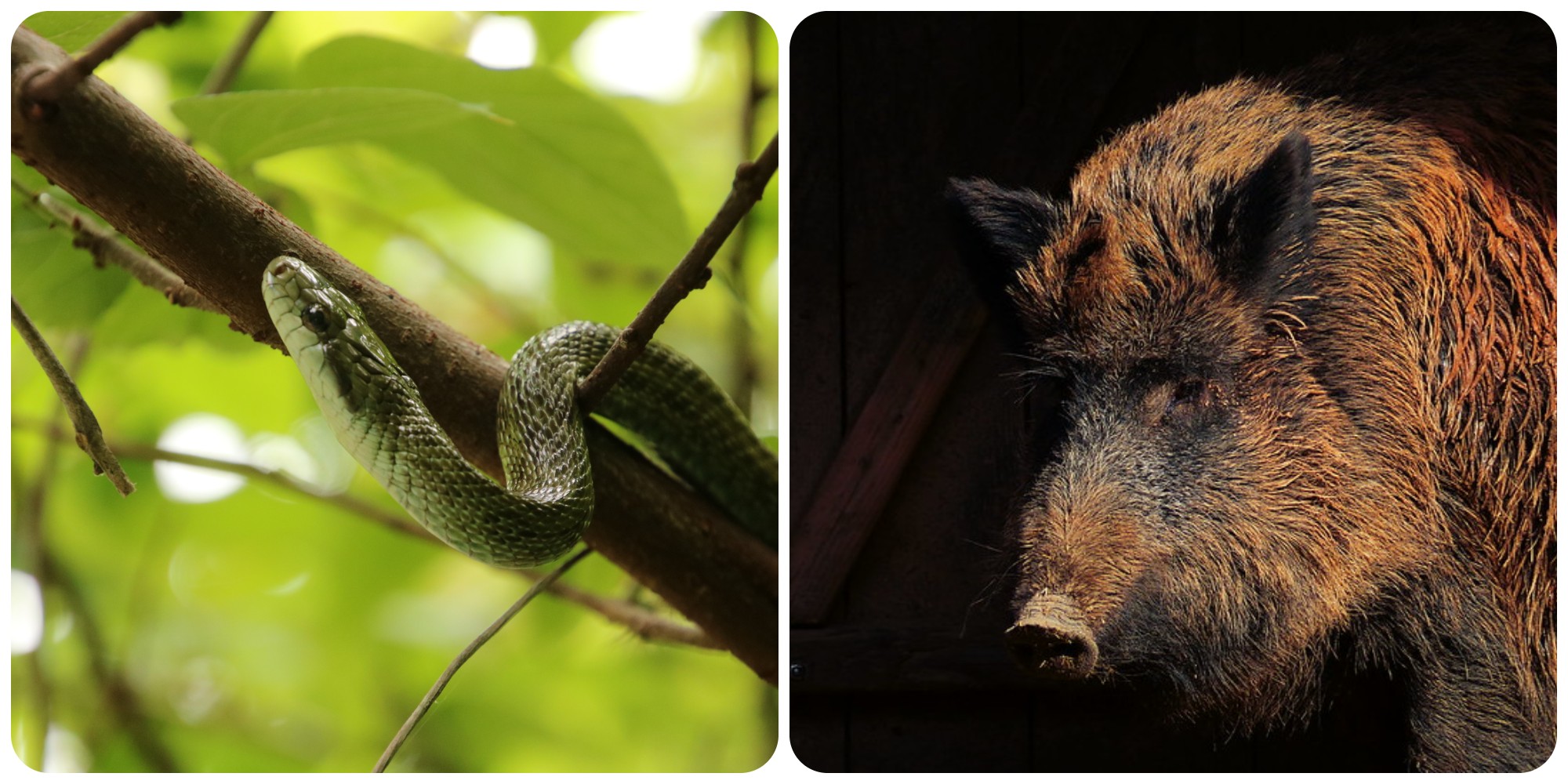
The research team studied rat snakes and wild boar across a range of radiation exposures, examining biomarkers of DNA damage and stress. Photos: Hannah Gerke/University of Georgia and Michael Eickelmann/Flickr
More than 10 years ago, the Great East Japan Earthquake and Tsunami damaged the Fukushima Dai-ichi Nuclear Power Plant, resulting in a massive release of radioactive material into the environment. Radiation dose rates led to the evacuation of over 150,000 residents from an area estimated at 444 square miles. Although people were evacuated, wildlife remained within the Fukushima Exclusion Zone, as it is sometimes called, and generations of animals have since been exposed to radiation levels above the safety threshold for human occupancy.
Colorado State University and the University of Georgia launched graduate student programs in collaboration with Fukushima University’s Institute of Environmental Radioactivity to conduct research on the effects of life-long radiation exposures to wildlife. Their most recent results were published online in Environment International and appears in the October issue of the journal.
What health effects have researchers found for wildlife in the Fukushima Exclusion Zone?
Between 2016 and 2018, the multi-disciplinary team studied wild boar and rat snakes across a range of radiation exposures in Fukushima. The team examined biomarkers of DNA damage and stress and did not find any significant adverse health effects.
Dr. Kelly Cunningham, first author of the paper and a recent graduate of CSU’s Doctor of Veterinary Medicine program, said the biggest takeaway is that perhaps people do not need to be as fearful of moving back into the remediated areas – 10 years after the accident – following this type of chronic, low-dose environmental radiation exposure.
The wildlife study is relevant to humans because human physiology is not so dissimilar to wild boar, said co-author James Beasley, an associate professor from the University of Georgia’s Savannah River Ecology Lab and Warnell School of Forestry and Natural Resources.
While mice have traditionally been used as a radiation biology model from which human effects are extrapolated, pigs – which are descendants of wild boar – are physiologically more like humans than mice and thus a more appropriate biomedical model species, he said.
Researchers respond to local residents’ questions
Hiroko Ishiniwa, a co-author and project assistant professor at Fukushima University, said the research helped respond to questions from local residents. In Fukushima, there have been many unfounded rumors about health effects related to radioactivity, she said.
“With hopes of explaining the situation, many local people took part in research activities, including capturing wild boars,” she said.
Thomas Hinton, a co-author on the paper and retired professor from Fukushima University, said environmental radiation decreased precipitously after the accident.
By the time this research began in 2016 to 2018, cesium-134, one of the major radionuclides released from the accident, had decreased by as much as 90% because of its short half-life. Hinton received his bachelor’s, master’s and doctoral degrees from CSU.
What signs of stress did researchers see for wildlife?
CSU Professor Susan Bailey, senior author on the paper, is an expert on assessing markers of stress and DNA damage due to radiation exposure.
She was a principal investigator on the groundbreaking NASA Twins Study, which examined the effects of space on identical twin astronauts Scott and Mark Kelly while one of them remained on Earth during a space mission. Bailey studies telomeres, or the protective “caps” on the ends of human, as well as wildlife, chromosomes.
Bailey said the telomeres of the boar and snakes could provide clues as to whether the animals were stressed from radiation exposures. “If the boar were stressed, we would see telomeres shortening,” she explained. “We didn’t see any changes related to radiation dose, and we didn’t see it in the snakes either.”
The researchers thought that with wild boar rooting behavior and snakes living in contaminated soil they would have received large doses of radiation.
Hinton said they spent a great deal of time quantifying the dosimetry – how much of the radiation was absorbed by wildlife – as precisely as possible.
The researchers also found lower levels of the hormone cortisol, a primary indicator of stress, in wild boar living within the Exclusion Zone. Bailey said this finding is supported by the fact that animal populations are thriving in areas where humans have not returned.
“It’s similar to what they’re seeing in Chernobyl,” she said. “The animals are flourishing mostly because there aren’t people around, and they don’t experience the related stress that brings.”
Cunningham, now working as a veterinarian in New Zealand, said being able to conduct this research while pursuing a DVM degree at CSU was amazing.
“It taught me about this other world of science aside from veterinary medicine,” she explained. “I had an opportunity to work with some of the leading radiation scientists from all over the world, and I could contribute with my veterinary skill set.”
She said being a member of the research team also helped her develop an interest in public health and epidemiology, which she hopes to explore more as her career progresses.
Additional co-authors on the study include Jared Luxton, Aryn Bordman, Lynn Taylor and Josh Hayes (CSU), Kei Okuda (Hiroshima Shudo University), Hannah Gerke, Sarah Chinn (University of Georgia), Donovan Anderson (Fukushima University), Mark Laudenslager (University of Colorado Anschutz Medical Campus), Tsugiko Takase (Institute of Environmental Radioactivity, Fukushima) and Yui Nemoto (Fukushima Prefectural Centre for Environmental Creation).